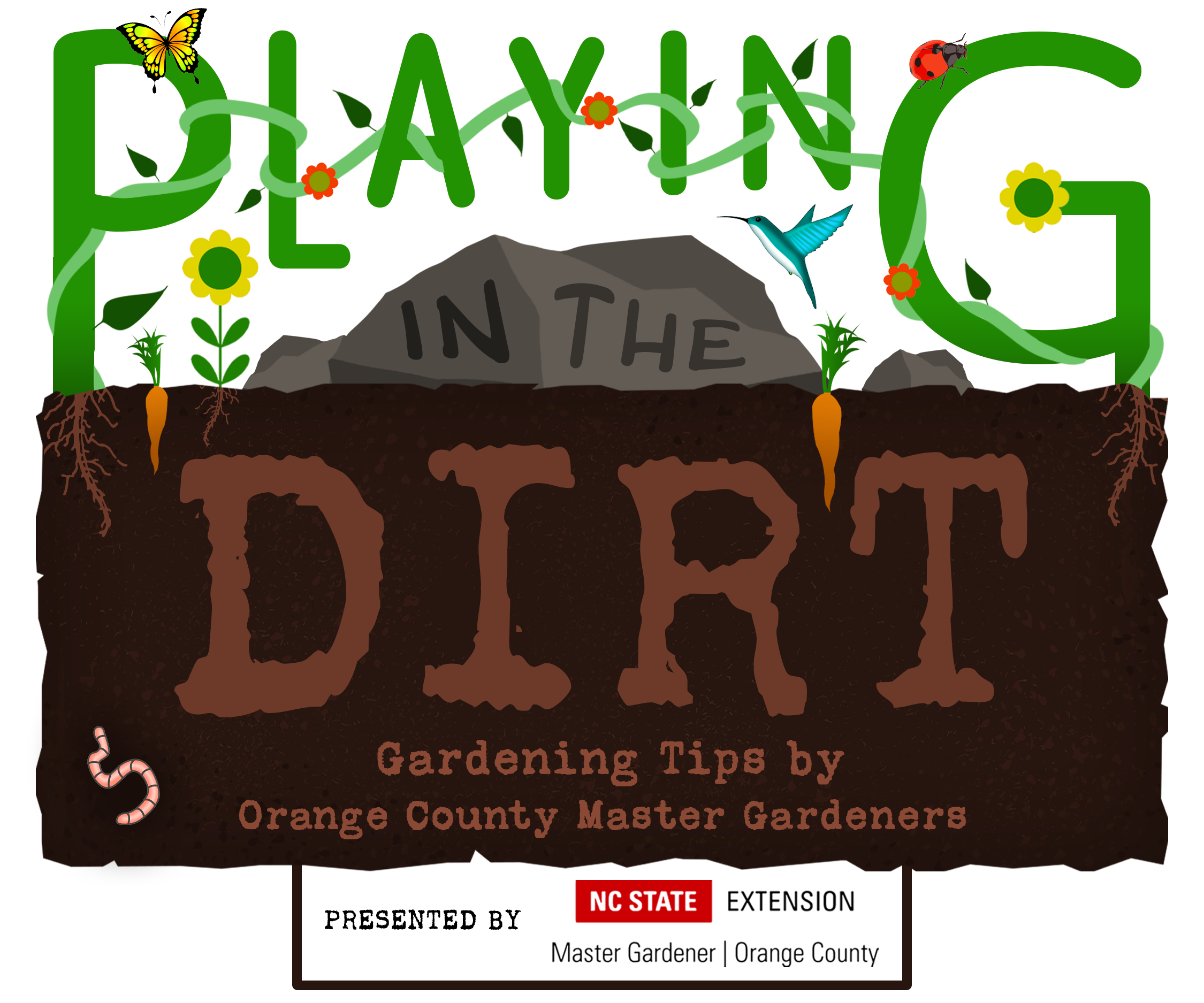
97.9 The Hill and Chapelboro.com have partnered with NC State Extension Master Gardener℠ volunteers of Orange County for “Playing in the Dirt,” a monthly column providing information and inspiration to gardeners of all skill levels! Check back on Chapelboro each month for a new subject – from our gardens to yours!
By Mitzi Bell Johnson, PT, DPT, MPH, Orange County Master Gardener℠ volunteer
Spring is a great time to get outside and combine the physical and mental benefits of gardening!
Getting dirty is not all that bad. In fact, it’s very good for you. In a meta-analysis of research published in 2017 in Preventive Medicine Reports, researchers Soga, Gaston, and Yamaura analyzed 22 case studies of the effects of gardening on human health, and noted that gardening was linked to reduced depression and anxiety, decreased body mass index, increased quality of life, and increased sense of community.
Remarkably, it’s reported that exposure to mycobacterium vaccae, a microbe found in the soil, triggers a release of serotonin in our brains. It makes us feel good.
What else? Well, gardening burns calories. The 2024 Compendium of Physical Activities contains an assortment of gardening activities and their corresponding metabolic equivalent of task (METs). For instance, weeding and cultivating your garden at light to moderate intensity generally uses 3.8 METs. This can be converted into calories burned over a certain period (METs x 3.5 x body weight (kg)/200=Kcal/min.) In this gardening scenario, our gardener who weighs 130 lbs. and weeds/cultivates for 30 minutes burns approximately 117 calories.
Now that we’re reminded of the benefits of gardening, how can we keep our backs and joints safe as we’re gardening in the presence of those “feel good” microbes? As we’re caring for nature, we need to care for ourselves and that means gardening with ergonomics in mind.
UNC’s Environment, Health and Safety department defines ergonomics as “the study of people in their working environment.” Our goal as ergonomically aware gardeners is to prevent injuries caused by poor body mechanics and repetitive motions while enjoying our gardening experience.
Before you get started
Warming up your body with exercise and stretching can help immensely with the quality of your gardening life. Generally, taking a 5- to 10-minute walk and/or stretching prior to gardening can help to foster a pleasant gardening experience even if you’re removing weeds! Your physical therapist or physician can guide you through a routine that will align with any physical or medical challenges you may have.
To help with comfort and safety, here are some items you may want with you in the garden:
- A good kneeling pad. These are preferable to knee pads because knee pads can sometimes become too tight and bind at the back of the knee.
- Appropriate gardening gloves for the task. The heavier duty the task, the more durability you’ll need from your garden gloves – water resistant, leather for prickly jobs, anti-slip rubber, or full-length for carrying brush.
- Safety goggles when appropriate.
- Water bottle to stay hydrated.
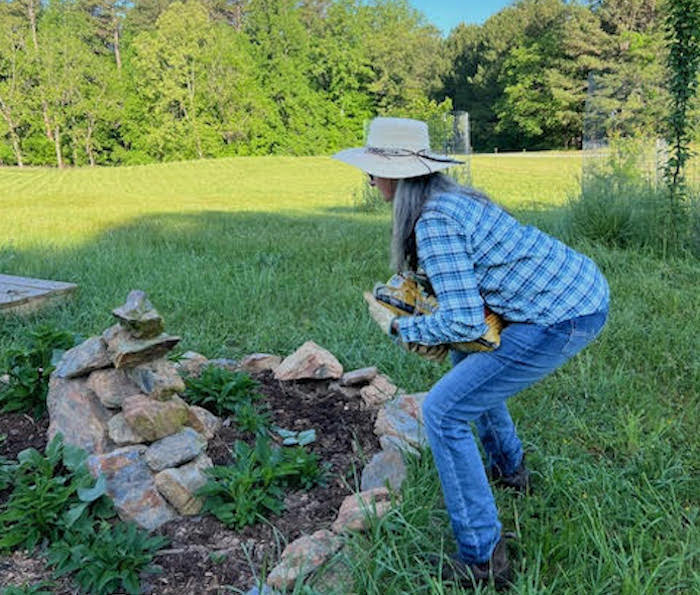
Proper body mechanics when lifting and lowering a 25-pound bag of worm castings. Photo by Mark Johnson.
Move loads carefully
Looking ahead to your task will help decrease the risk of injury. Think of how you’ll get all your gardening items, whether bags of mulch or tools, to their destination in the garden. Wheeled carts or a wheelbarrow can be very helpful.
Divide your load into a weight that is manageable if lifting is involved. Carry that smaller load close to the center of your body. Face the item you’re lifting.
When lifting or lowering your bag of mulch, place your feet shoulder width apart and bend your knees. Your knees should be over the top of your toes but not beyond or in front of your toes. Your back should be straight. Remember that the bending and straightening movement comes from hinging at the hips. Lift and lower your body by using your thigh muscles (quads) and your buttock muscles (glutes). If you must turn, do so by taking small steps, don’t twist.
Divide your task into smaller steps so that you can take rest breaks and reduce repetitive movements. And ask for help when you need it. As the old proverb says, “Many hands make light work.”
Use the right tool for the job
Use the right tool for the job to minimize injury. You’re likely to get back out into your garden and enjoy the task if you’re efficient.
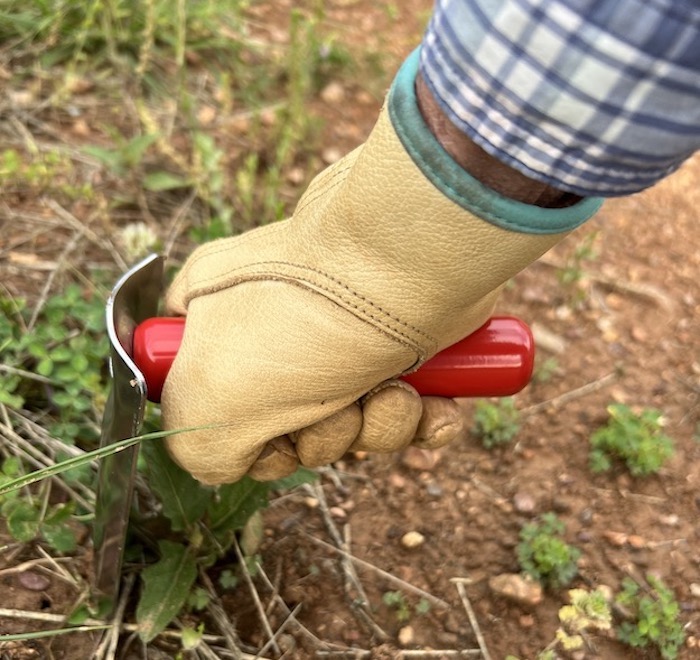
Digging a weed out to create a hole for compost and a new plant. Wrist is in neutral. Photo by Mitzi Bell Johnson.
Sharpen tools that might be dull to save your energy and decrease overusing your muscles. Nothing is worse than a dull shovel that won’t cut through tough grass or weeds.
Try a right-angle trowel: When propagating and planting, you’ll need a trowel, which is a handheld garden tool with a curved scoop for lifting plants or soil. Ideally, the trowel will have a handle that is 90 degrees to the plane of the scoop. The right-angle trowel allows for the wrist to be held in a neutral position, lessening the stress on wrist tendons.
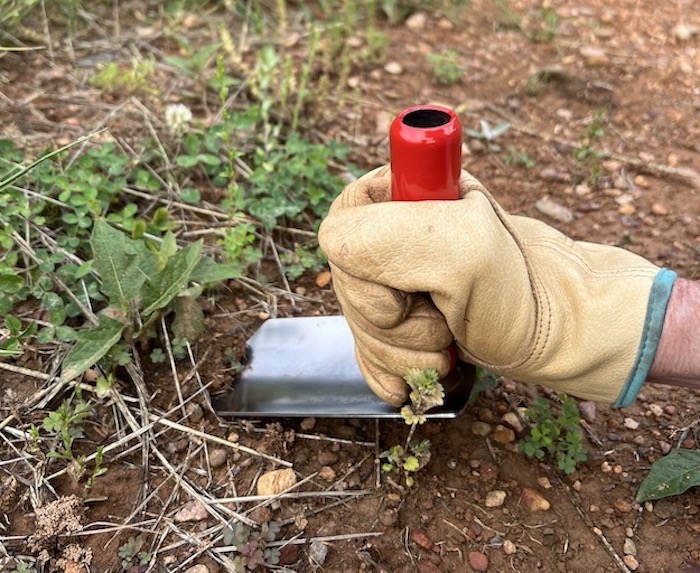
Digging under a weed with a right-angle trowel. Wrist is in neutral position. Photo by Mitzi Bell Johson.
The hand grip should be comfortable and non-slip. The more gardening you participate in, the more you will appreciate these ergonomic design perks.
Use tools for weeding: Try to use a tool for weeding instead of doing so by hand. This helps minimize repetitive fine motor movements and decreases bending over or kneeling to pull weeds. By using the larger muscles of the shoulder and a weeding tool, you can protect the smaller delicate muscles of the hand and fingers.
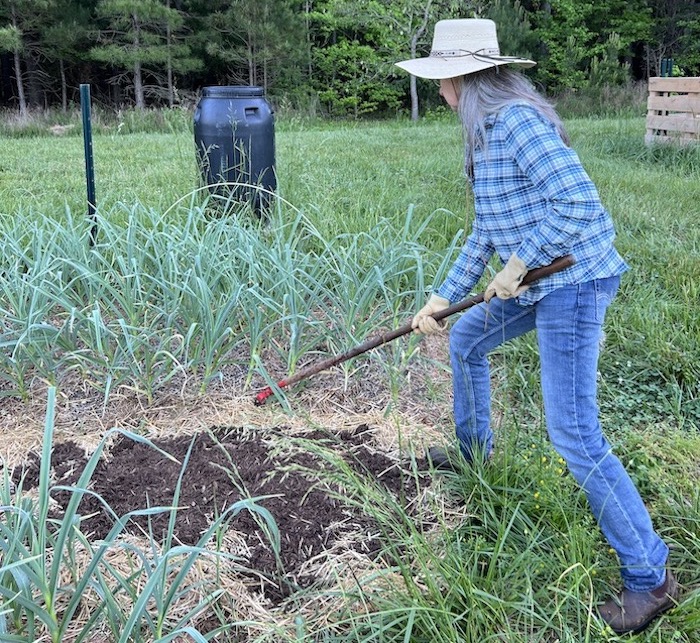
Weeding using a stirrup hoe, with one leg forward. Photo by Mark Johnson.
Stirrup hoes are great weeders! This tool utilizes a push-pull motion to cut the roots just beneath the soil. It is best used on fertile soil after a fresh rain and on young weeds. This tool can be challenging to work with in thick mulch, hard clumpy clay that has not been amended, rhizomatous stems, and long tap roots. A triangular hoe works well on clumping weeds.
A ladder for pruning or trimming: When you are pruning trees or clipping hedges, use a ladder of appropriate height so that you can keep your head in a neutral position, and looking ahead. This also allows your arms to be level to or below shoulder height (meaning less stress for rotator cuff muscles that can be pinched as we raise our arms above our shoulders).
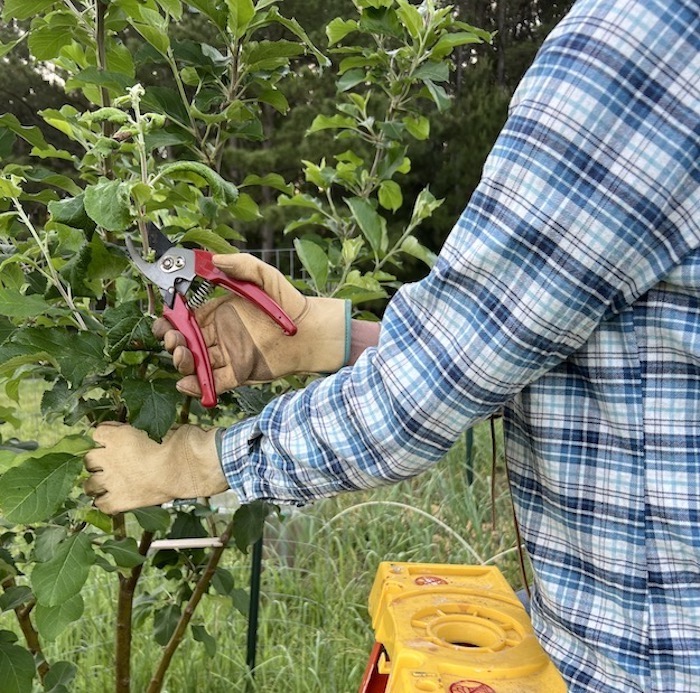
Pruning an apple tree standing on a ladder. Notice hands are lower than shoulder height, elbows are close to body, and wrist using secateurs is in a neutral position. Photo by Mark Johnson.
Good posture when raking: With a task such as raking, it is important to have a handle that is long enough so that you’re not bent over. You should bend your knees and place your legs in a straddle position with one foot forward of the other. Use a rocking motion forward/backward with the rake. Change up this task with other tasks frequently and your back will thank you! When leaves are wet, they can become a slipping hazard, so if you choose to leave your leaves, strategically place them.
How to reduce bending: Some garden designs can reduce the amount of forward bending, such as a 3- to 4-foot raised garden bed with a built-in seat along the perimeter. Vertical supports for pole beans, squash, cucumbers, and peas can bring the plant into your view for inspection and harvest. Netted bags can carry the weight of a pumpkin or squash in a vertical garden and allow you to harvest at waist height.
As spring moves forward, let’s get out there, enjoy our North Carolina skies, and get our hands in the earth!
Read more:
- Gardening is beneficial for health: A meta-analysis. Masashi Soga et al., Preventive Medicine Reports, Vol. 5, pages 92-99, March 2017.
- SRL172 (killed Mycobacterium vaccae) in addition to standard chemotherapy improves quality of life without affecting survival, in patients with advanced non-small-cell lung cancer: phase III results. M.E.R. O’Brien et al., Annals of Oncology, Vol. 15(6), pages 906-914, June 2004.
- It’s in the dirt! Bacteria in soil may make us happier, smarter. Naomi Sachs, Therapeutic Landscapes Network, reprinted in National Wildlife Federation blog, Jan. 6, 2016.
- Compendium of Physical Activities: Lawn & Garden. Journal of Sport and Health Science, Jan. 17, 2024.
- Metabolic equivalents for weight loss: What they are & how to calculate them. Jacqueline Kaminski, National Academy of Sports Medicine.
- Stretching, 40th anniversary edition. Bob Anderson and Jean Anderson (illustrator). Shelter Publications, 2021.
More from the Master Gardener volunteers of Orange County:
- Have a plant or garden question? Email the Orange County Master Gardener volunteers at ocmgardeners@gmail.com or phone 919-245-2061.
- Subscribe to The Garden Buzz, the Orange County Master Gardeners’ monthly newsletter, for gardening news and tips. And visit our website, The Orange Gardener, for helpful gardening information and tips.
- Follow us on Facebook! Our page is Orange County NC Extension Master Gardener Volunteer.
Chapelboro.com does not charge subscription fees, and you can directly support our efforts in local journalism here. Want more of what you see on Chapelboro? Let us bring free local news and community information to you by signing up for our newsletter.

